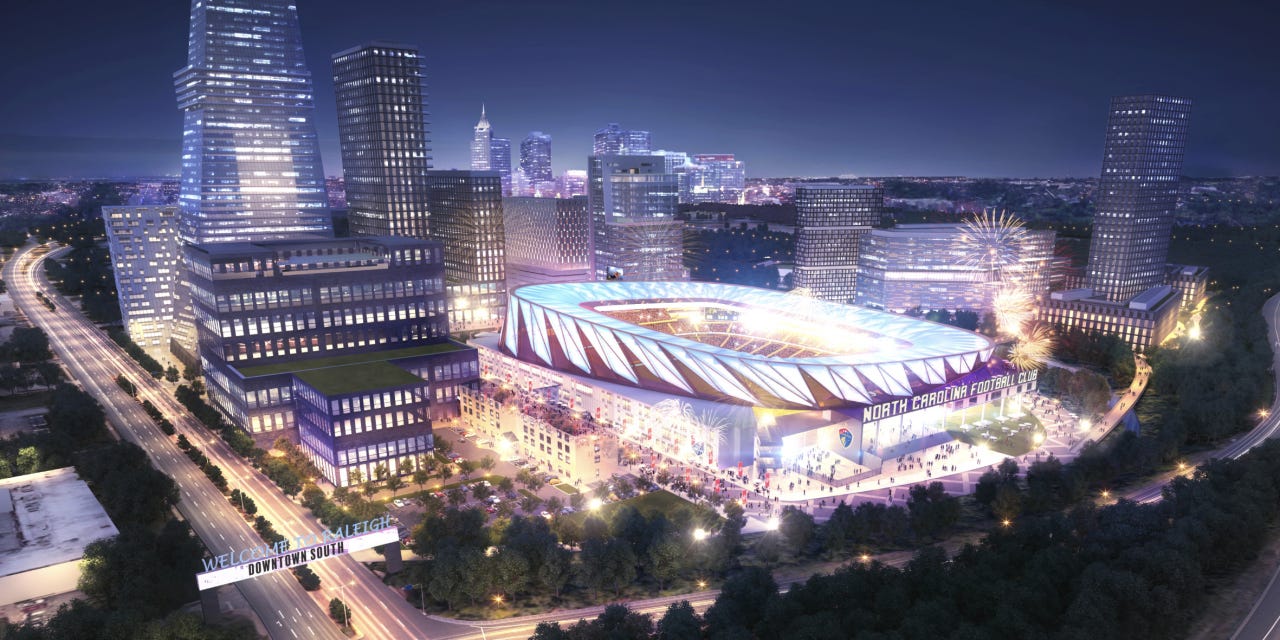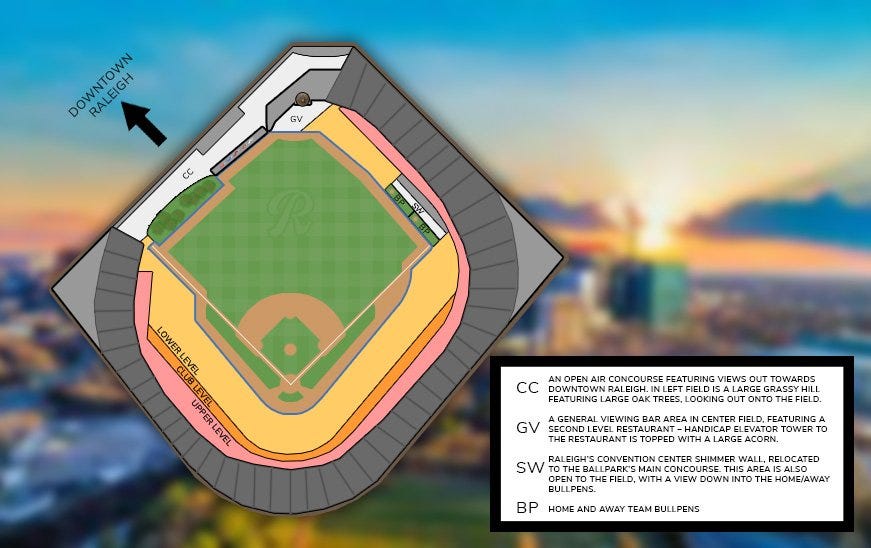Raleigh Sports: ...Where Are They?
How is a city of nearly half a million this bereft of sports?
I’ve lived in Raleigh for a little over two months now. It’s the first time I’ve lived in a true city since I left Minneapolis for Chapel Hill in 2019,1 and I’m enjoying it overall, but a few things are still a little off-putting to me compared to how it was in the Twin Cities. There’s no major waterfront,2 no light rail transit or really anything even close to it,3 and as far as I’m aware, no pizza joint that serves my beloved mac and cheese pizza. But this is all small fries compared to what I think is the single weirdest thing about Raleigh—something that sets it apart from nearly every other major city in the United States:
Sports are basically non-existent here.
Before I expand on this, let me clarify two things. First, I’m talking about the city of Raleigh proper. Not Raleigh-Durham. Not the Research Triangle. Just Raleigh. Despite their proximity, Raleigh and Durham are different cities with different cultures and vastly different living experiences. Second, I’m referring to sports as entertainment, not as recreation. Raleigh has a decent recreational sports scene that I regularly participate in; it just doesn’t have many spectator sport viewing experiences.
For starters, Raleigh is pretty short on nationally relevant sports teams. Of the five major pro sports leagues in the U.S., Raleigh has a team in just one: the NHL’s Carolina Hurricanes.4 This isn’t really surprising given the city and region have only begun to boom in the past few decades, but it’s still a little jarring to look at the lists of TV markets and Combined Statistical Areas in the U.S.—where Raleigh-Durham ranks 24th in households and 32nd in population, respectively—and see the Triangle ahead of various markets with multiple pro sports teams, all of which the Triangle far outpaces in population growth.5 The logical reason for this is the region’s proximity to Charlotte, a larger market with a less transient population. Charlotte has teams in the NFL, the NBA, and—as of this year—MLS. The closest MLB team to Raleigh is a four-hour drive north in Washington.6
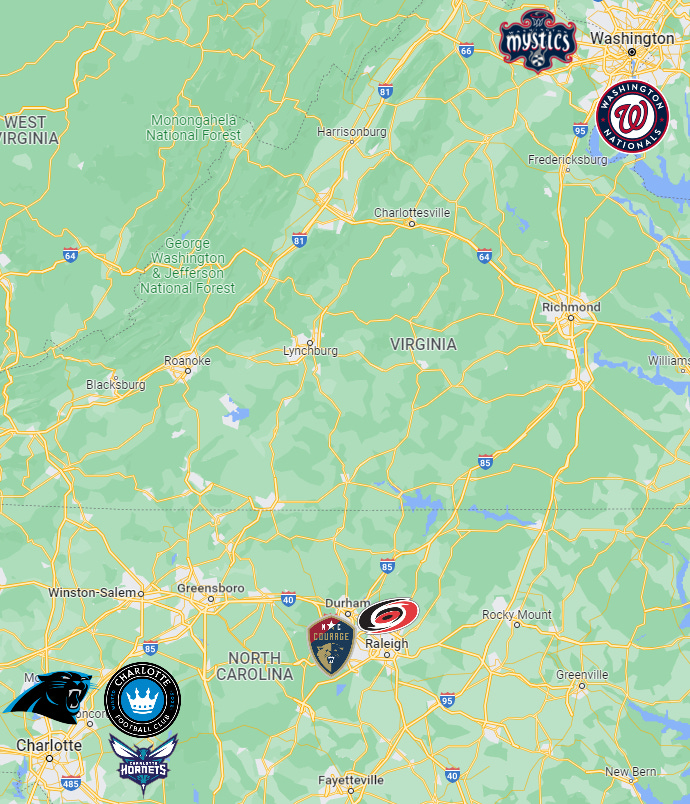
The Hurricanes are the only pro sports team to play within Raleigh city limits. The region’s two soccer teams—the North Carolina Courage of the NWSL (the top tier of women’s soccer in the country) and North Carolina FC of USL League One (the third tier of men’s soccer)—play just across I-40 at WakeMed Soccer Park in Cary, but that’s it for the immediate Raleigh area.
The city hosts no other pro or semi-pro teams in any sport, most notably baseball, which hasn’t been played professionally in Raleigh since 1972. For minor league baseball, you have to drive 25 miles in one of two directions: northwest for the Durham Bulls or due east for the Carolina Mudcats, who play in Zebulon, all the way out in the eastern exurbs. They should play in Raleigh, and in fact, it was Raleigh where the owner wanted to put the team in relocating it from Columbus, Georgia, in 1990. Then the Bulls took advantage of a Minor League Baseball bylaw that gave each team territorial rights to everything within a 35-mile radius of their home ballpark—which, for the Bulls, includes the entire city of Raleigh—so if the Mudcats wanted to move to the region, they had to find a spot outside that circle; Zebulon is 37 miles from Durham as the crow flies.
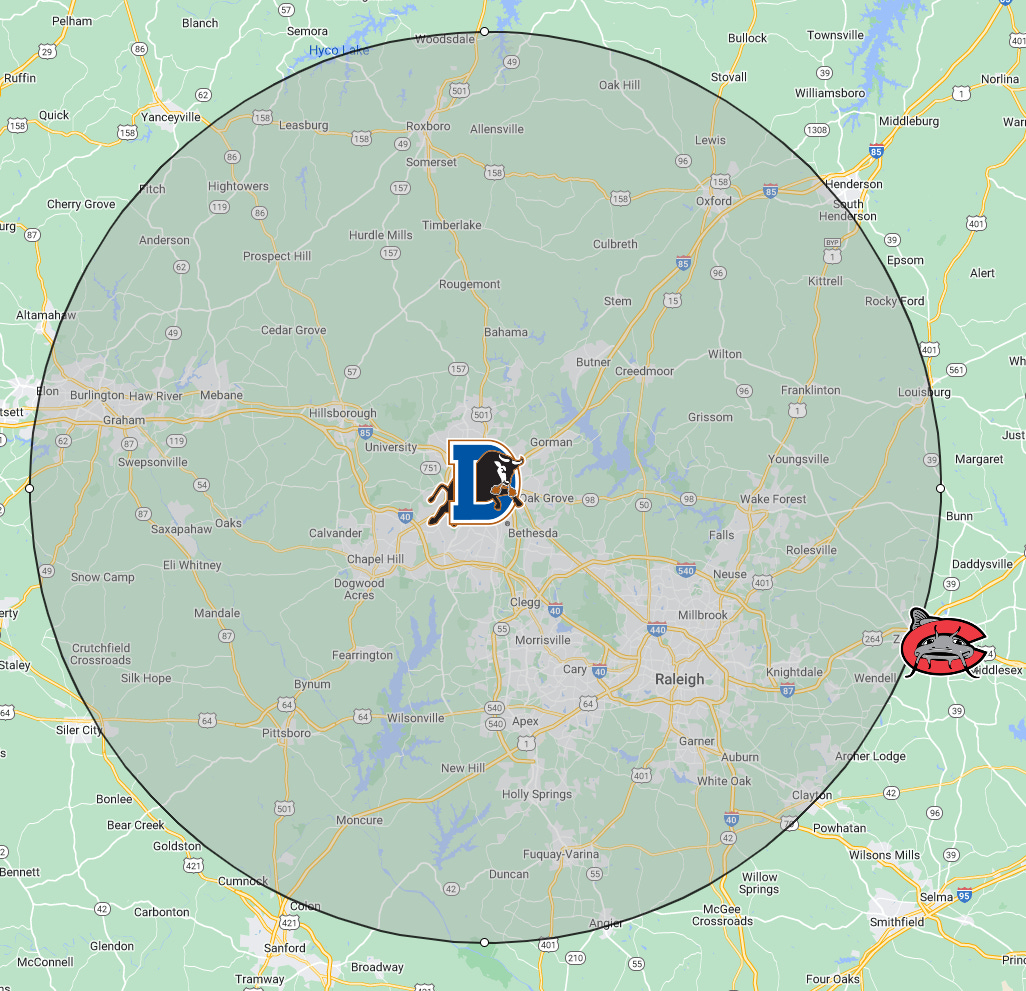
But enough about pro sports! They’ve never been the Triangle’s calling card. With three NCAA cornerstones in UNC, Duke, and Raleigh’s own NC State, it’s all about the college game here! Except, in Raleigh itself, this is frankly overstated. First, while NC State is, by enrollment, the largest institution in not just the Triangle but the entire state, you don’t need me to tell you that their athletic programs act as a third wheel to UNC and Duke more often than not.7
More important is where NC State’s major athletic facilities are located. With respect to the rest of the vast college athletics landscape, which I’ll get to momentarily, the two most prominent sports are men’s basketball and football, and NC State’s facilities for these sports—PNC Arena and Carter-Finley Stadium, respectively—are in the middle of nowhere. They’re adjacent to each other, but tucked away in the western outskirts of the city, three miles away from the bulk of NC State’s campus and five miles away from downtown Raleigh. They’re also nearly impossible to reach any other way than by car, as there are alarmingly few sidewalks connecting the city center to this neighborhood and transit service from one to the other takes impractically long and requires at least one bus transfer, sometimes multiple. This all serves to a) further distance them from the rest of the city,8 and b) completely destroy traffic everywhere in the general area on game days.9
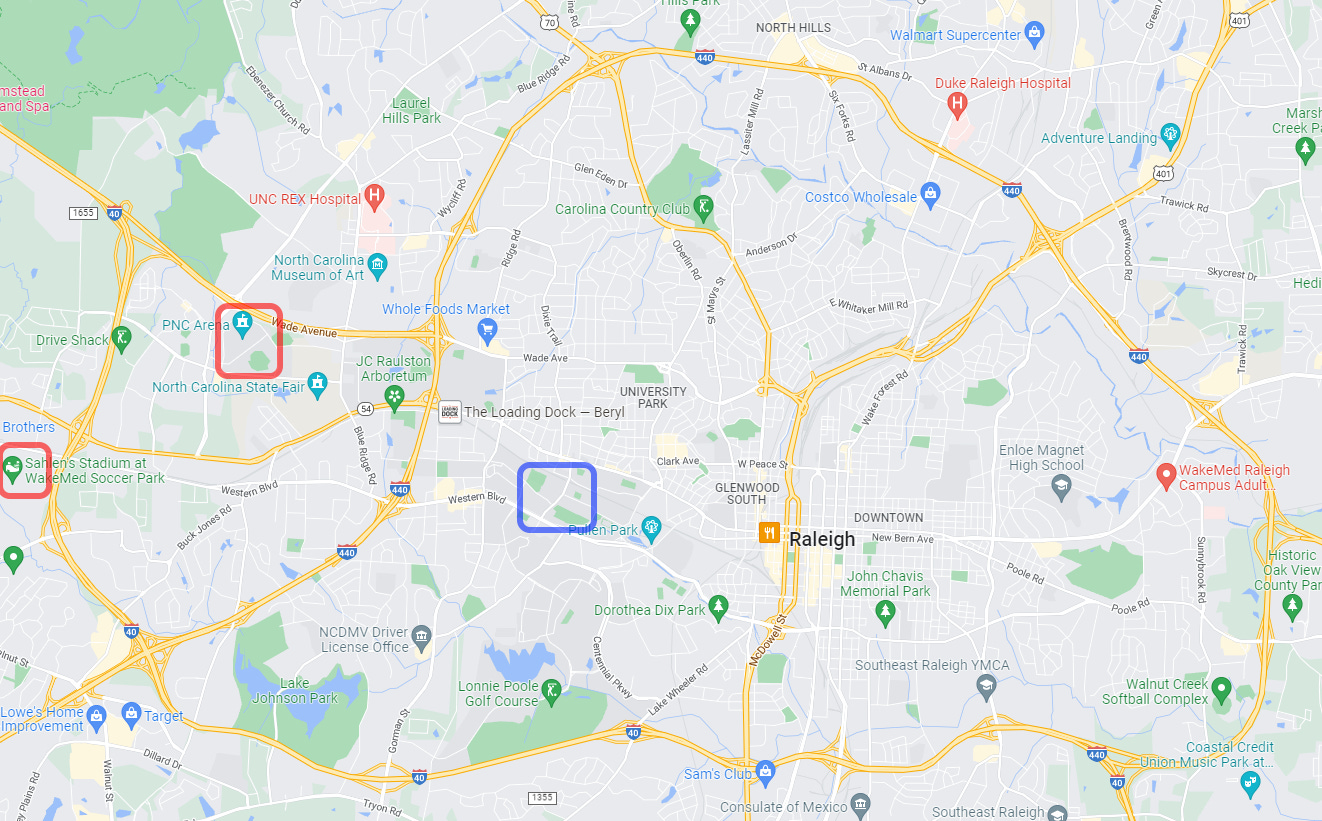
But this isn’t just true of NC State men’s basketball and football; the Hurricanes also play at PNC Arena and face the exact same issues, and the two soccer teams that play in Cary have it even worse. The only notable spectator sport viewing experiences that are actually woven into the fabric of Raleigh are the less prominent NC State sports, for which the teams actually play on campus. Most significantly, this includes the women’s basketball team and the baseball team, which play at Reynolds Coliseum and Doak Field, respectively. Make no mistake, these are popular teams—and both are currently in the midst of golden ages—but their popularity is restricted to such specific niches that the city at large isn’t as invested in them as they would be for a more nationally relevant team of their stature.10
Beyond this, all the city has are a few institutions in the lower divisions of the NCAA11 and then, like…high school sports? Which obviously a young adult from out of town with no children has no good reason to care about. And that’s it.
This isn’t normal. It’s natural for me to compare this to other places I’ve lived. In the Twin Cities, most of the sports are concentrated in downtown Minneapolis, with the others immediately reachable by light rail. In Lincoln, a city more obviously comparable to Raleigh, the University of Nebraska’s football stadium is on campus and its basketball arena is immediately adjacent, with a baseball stadium shared by the university and an indy league team in walking distance, as well as a junior hockey rink. Even Sioux Falls, a city significantly smaller and less notable than Raleigh, has it better: within walking distance of downtown are an indoor football/junior hockey arena and an indy league baseball stadium.12
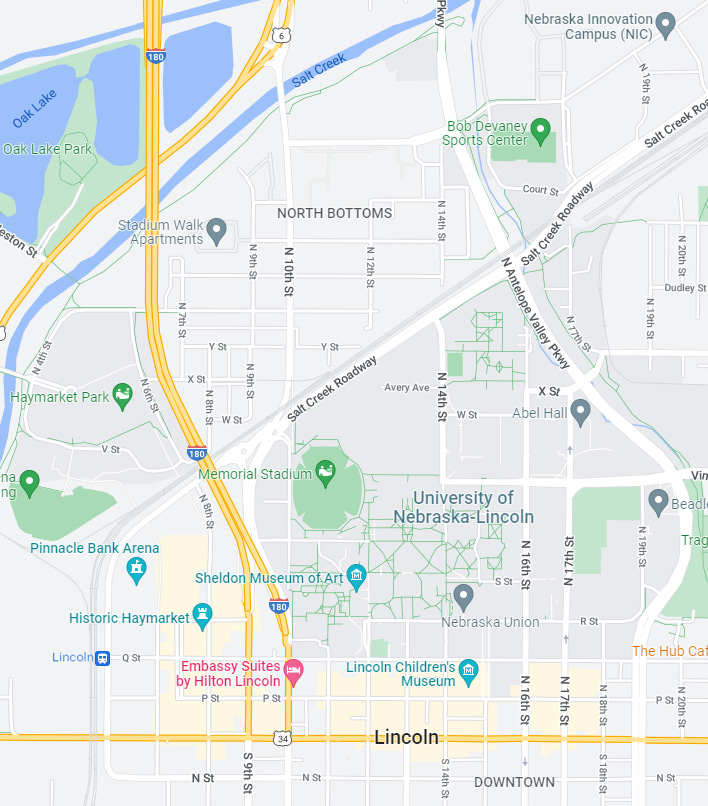
The only analog I can think of in the U.S. is Kansas City, where MLB’s Royals and the NFL’s Chiefs play in a giant parking lot hidden in the hills southeast of the city, while the MLS team, the indy league baseball team, and the NASCAR track are in the far western outskirts on the Kansas side and the minor league hockey team plays in suburban Independence. But even this city has a saving grace: college basketball. The University of Missouri–Kansas City’s mid-major basketball team plays at a downtown arena, and in case that's not good enough, an even bigger arena a few blocks away hosts early-season tournaments, the Big 12 conference tournament, sometimes a couple rounds of the NCAA Tournament, and usually at least one Kansas Jayhawks game per year despite the University of Kansas being 35 miles away.
Raleigh doesn’t even have this opportunity because, aside from the mid-sized venues on NC State’s campus, it doesn’t really have an adequate space to host large events aside from the two well outside the heart of the city. I’m far from the first Raleighite to see this as a problem; Mayor Mary-Ann Baldwin attended the Courage’s NWSL championship victory at WakeMed Soccer Park in 2019 and lamented that it took her 45 minutes to get there, adding that Raleigh needs a downtown stadium. This came after Charlotte was awarded the MLS team that began play this year and in the midst of a string of downtown stadium proposals that stretches back to 2017, when Raleigh was still seriously bidding to land that team. Courage and North Carolina FC owner Stephen Malik has been the driving force behind all of these proposals. First, he wanted to put the stadium just north of downtown,13 but that fell through and he has since focused on revitalizing a large swath of mostly industrial land south of downtown along I-40: a development cleverly named Downtown South. This proposal has also been kyboshed, at least for now, because the city government isn’t currently willing to finance it, which—best I can tell—is due to some combination of the pandemic screwing up finances and city politics making it a bad time.14
It’s gotten to the point where these stadiums have become the stuff of legend, a part of some mythologized version of Raleigh we may never get to live in. Nowhere is this more apparent than with MLB Raleigh, a grassroots movement to bring a future MLB expansion team to the city. It’s well supported by both existing data and projected trends but can still charitably be described as a long shot: MLB has publicly expressed interest in expanding to a laundry list of cities but Raleigh isn’t one of them,15 there’s no obvious source of funding, and—of course—it’s not clear where they’d put the stadium. But this was also mostly true of Raleigh’s MLS bid and, as with that venture, the long odds haven’t stopped people from dreaming. The MLB Raleigh website contains various mockups of possible stadiums and some supporters have effortfully created their own, like the one shown below.
Despite how implausible it seems for Raleigh to get awarded an MLB team in the face of other, more established bids, I’m unequivocally rooting for it. It’s a testament to this city’s hunger for sports that this much thought is being put into ideas that are so unlikely to become reality.
At the same time, it’s only human. Sports have been intrinsic to society for millennia. It’s only natural for us to want to experience them without having to stall in traffic on Wade Avenue or drive 45 minutes to Cary.
I’ve lived in the Research Triangle since 2019, first in Chapel Hill and then in Cary before moving to Raleigh.
In fact, none of the major cities on the North Carolina piedmont are built around a body of water; they’re all rail cities through and through. This is crazy to me given how rare this is nationwide.
The most recent (failed) light rail transit proposal was just to connect Durham and Chapel Hill. Commuter rail looks like it’s gonna be in the works, but it’s still a ways away.
Yes, I’m counting MLS as a major league. It has by most accounts surpassed the NHL in popularity, adding a little insult to injury in that not only does Raleigh only have representation in one of the five major pro sports leagues, but the league it is represented in is also the least popular of the five.
I know I said I’m only talking about Raleigh, and that’s still true, but the demographics of the whole region matter here.
Let’s be honest: at least five hours with I-95 traffic.
Why yes, I am a UNC grad. But also, I’m not wrong. NC State is obviously a basketball rival but ESPN isn’t breaking viewership records for Kevin Keatts’ last home game.
It’s also worth noting that the wide majority of Raleigh’s Black population lives in the eastern half of the city, making the stadiums’ placement in the far west even more inaccessible to them. I suppose this is preferable to razing a minority neighborhood to build an arena like a lot of other cities did.
This is also where the North Carolina State Fairgrounds are located, which causes the same problem for a week and a half straight in mid-October.
I wish this wasn’t the case; women’s basketball and college baseball are both incredibly fun sports and both, especially the former, deserve more attention than they currently receive.
Shaw University in Division II; Meredith College and William Peace University in Division III
I’m not suggesting arena football or junior hockey qualify as “nationally relevant”, but given the lack of any major sports in about a three-hour radius, Sioux Falls cares about them a lot more than Raleighites unaffiliated with NC State care about Wolfpack baseball.
This is also the former location of Devereux Meadow, where Raleigh’s minor league baseball teams played back in the day.
In summer 2021, Raleigh (and a bunch of other municipalities) pushed their local elections back from November 2021 to November 2022 without any public input due to a delay in U.S. Census data making redistricting impossible before elections were originally scheduled. This drew widespread ire, including a failed recall campaign on Mayor Baldwin.
Predictably, Charlotte is.





